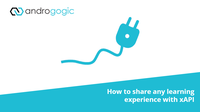How to share any learning experience with xAPI
What is xAPI?
The Experience API (or xAPI) is a specification that allows learners to keep records of a virtually limitless range of their learning experiences.
If you’re familiar with SCORM learning packages, you know that to track a learner’s completion of the SCORM activity, the completion data from the SCORM object can only return to the LMS for storage (and then must be federated back out to other systems from the LMS). With xAPI, you’re not limited to completing an activity connected to an LMS. In fact, the sky's the limit when it comes to what, where and how to record learning activities and experiences.
For example, learners can track
- Simulation games
- On the job training
- Offline learning, like reading a book
- And much more
How does xAPI work?
xAPI’s flexible learning statements allow you to track and share any kind of learning activity.
A statement is sent to a Learning Record Store (LRS) which stores all of the learning activities that a person experiences. The statement is sent in the form “Noun, verb, object” like, “I surfed Copacabana,” so that you can record virtually any kind of learning experience.
xAPI offers you total freedom. Use it from any device, with limited internet connectivity, and outside the confines of an LMS.
Share your learning between institutions
Easily take your learning with you, wherever you go. Because xAPI isn’t limited to just tracking learning experiences, but sharing them as well, moving between institutions becomes seamless.
For example, you have a doctor working at one hospital that needs to quickly transfer to a new hospital. In order for her to do so, you need to ensure her new hospital has access to all of her compliance training data so she can start work straight away.
If all of her data is just stored on an LMS, she might be able to request her results be exported and sent to her new hospital, where her Recognition of Prior Learning is entered into the new system. But this could take days to do, which means she can’t do her transfer as quickly as required.
However, if her compliance training was using the xAPI framework and stored in a Learning Record Store (LRS) that both hospitals were connected to, both hospitals will already have her training data, and she’s good to go immediately.
Do I need an LMS to use xAPI?
The short answer? No.
xAPI speaks directly to the Learning Record Store, so while using an LMS is useful to store courses, programs, and certifications, it’s not necessary to have one to use xAPI. Unlike SCORM, the learning object doesn’t have to originate inside an LMS and anything can become a learning object.
LMSs are however still great for user management, scheduling face-to-face training, tracking CPD, and maintaining a course catalogue for formal learning opportunities. So, while it is possible to use xAPI without an LMS, there is still a place for the LMS in the broader teaching and learning ecosystem.
Androlytics xAPI LRS
The flexibility of xAPI meets the technical experience of Androgogic in the Androlytics xAPI LRS. A secure, centralised system, it provides access to detailed reports, informative administrator dashboards, and learning data at a glance.
Its flexibility complies with international standards and will interoperate with existing systems such as:
- Learning Management Systems (LMS) like Totara Learn
- Learning Experience Platforms (LXP) like Totara Engage
This means that you can extend your existing workflows accessibly and cost-effectively. Furthermore, if you are required to send the information to external organisations for auditing or certification, you can easily do so using the centralised system.
There are unlimited opportunities waiting for you with the Androlytics xAPI LRS. Now that you know what it is and how it works, get in touch so we can help you get started.

